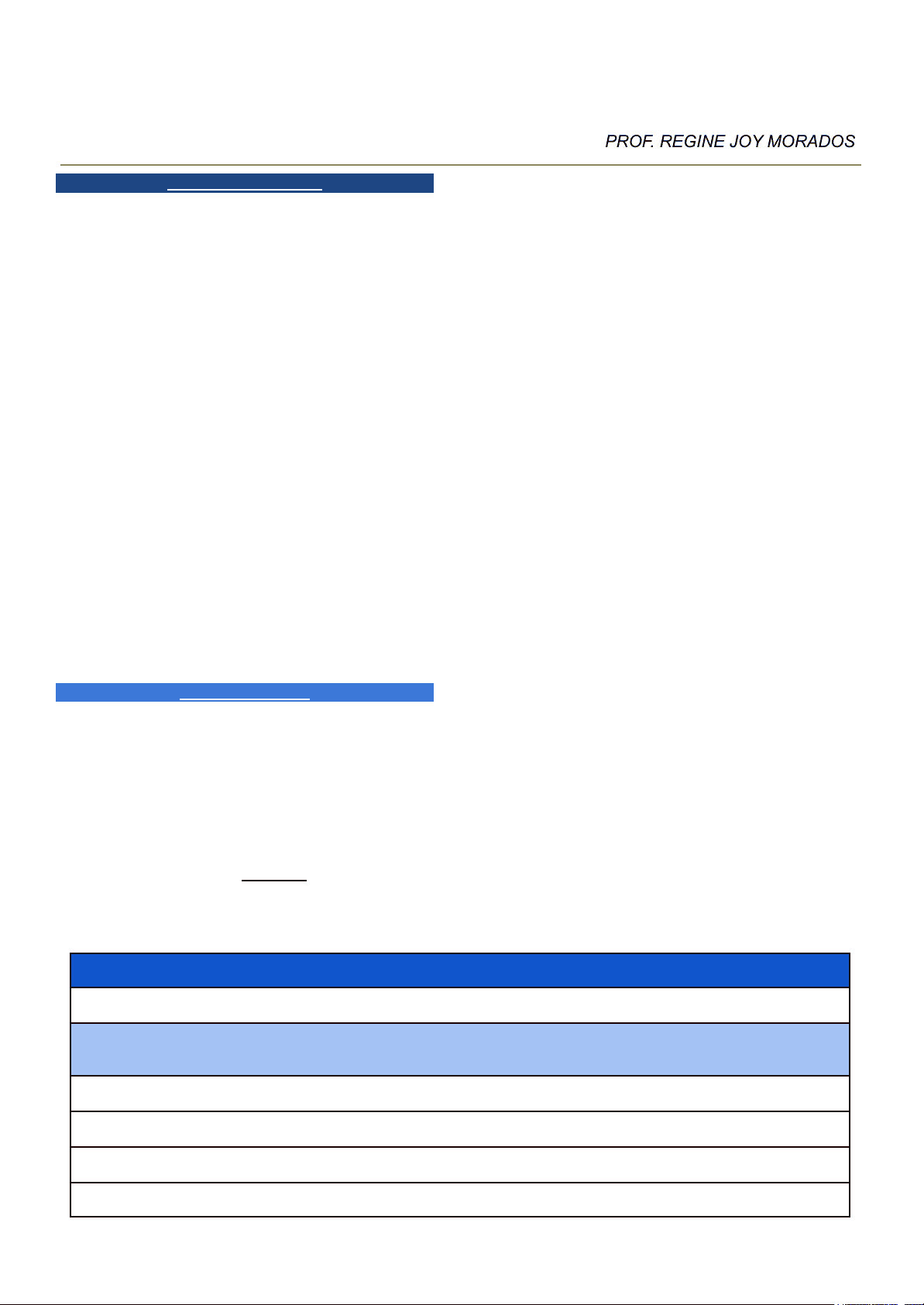
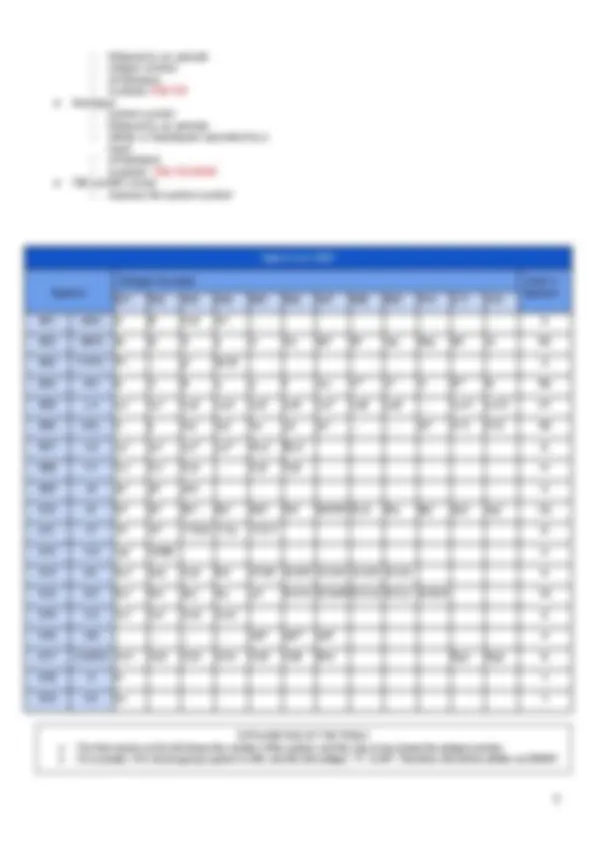
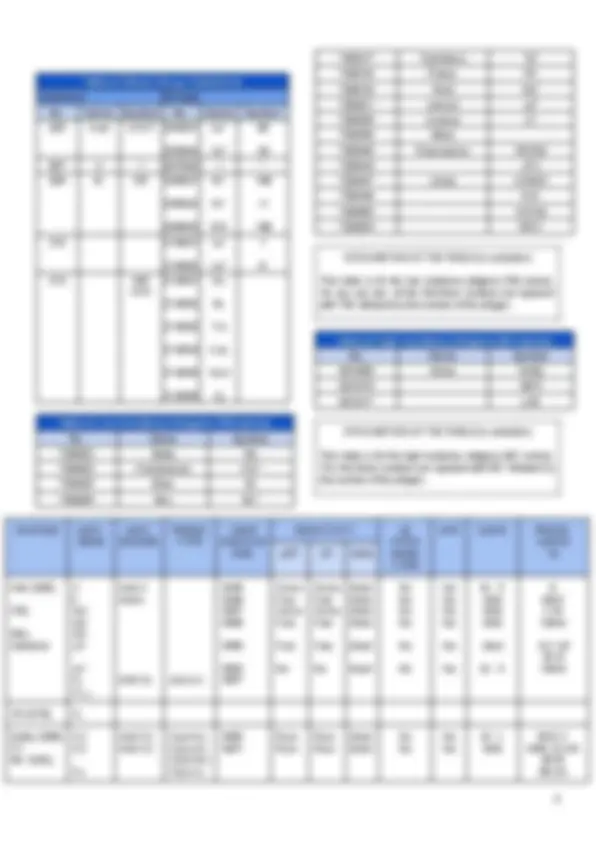
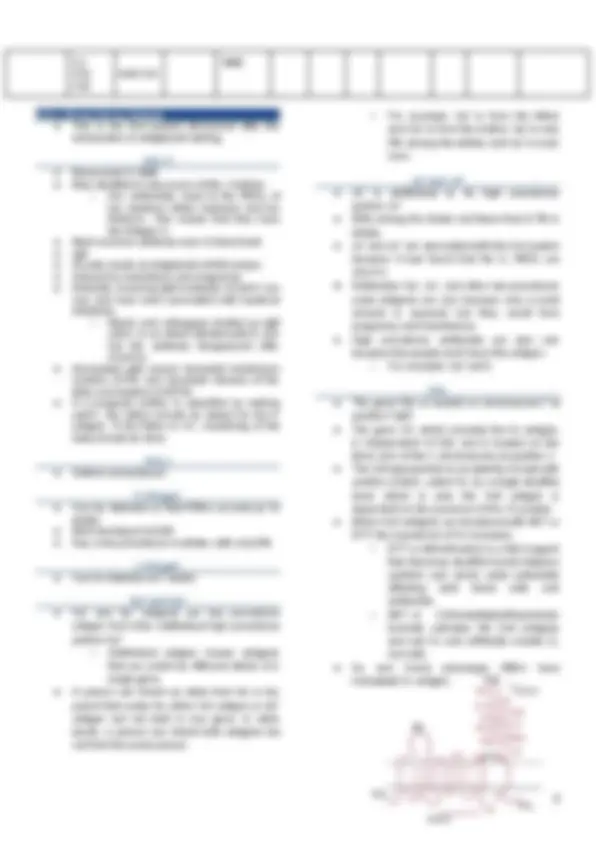
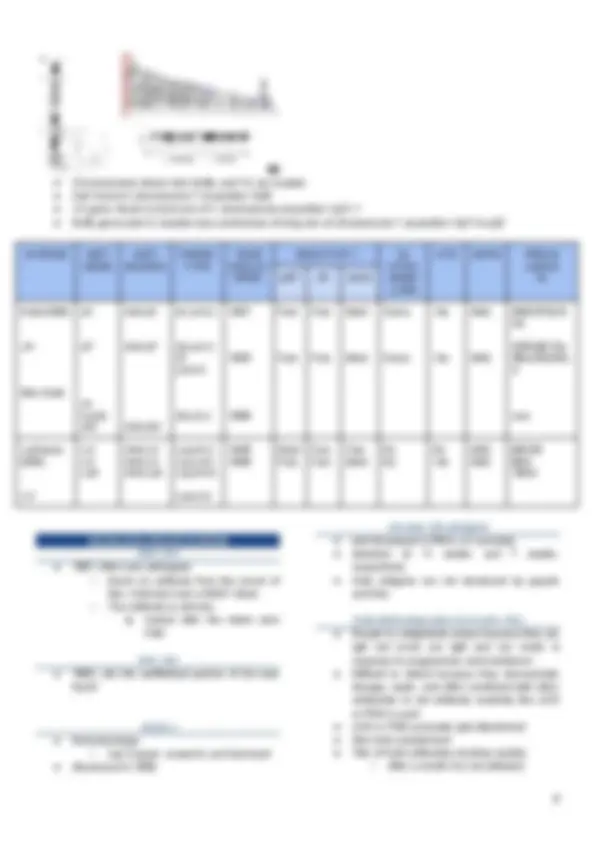
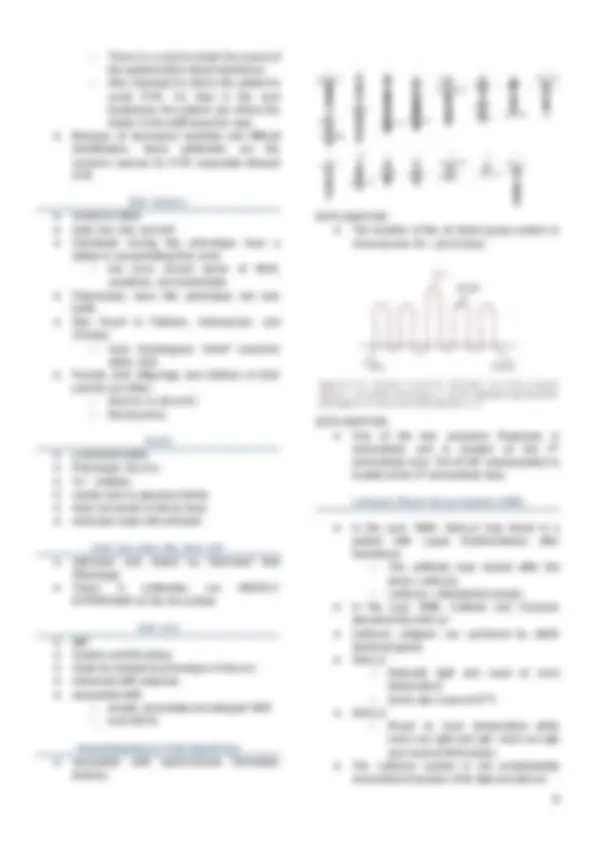
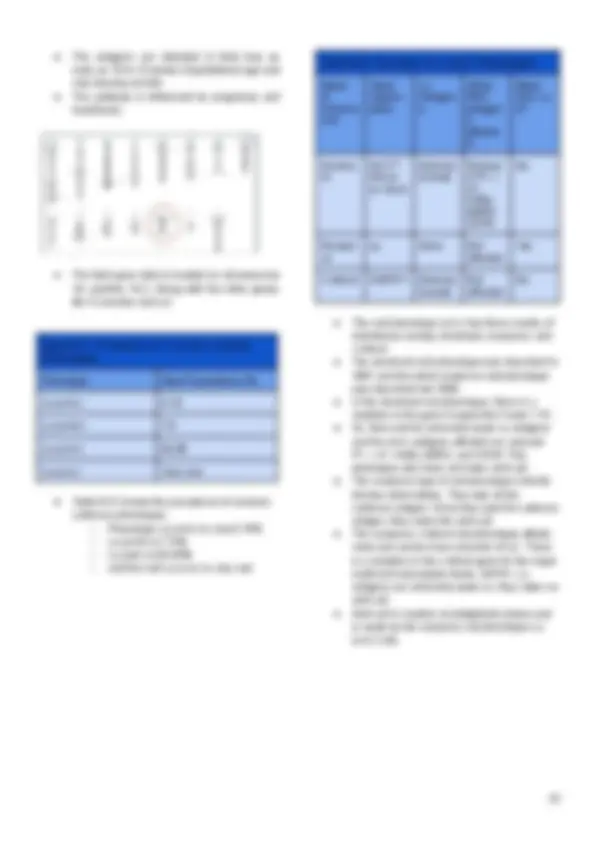


Study with the several resources on Docsity

Earn points by helping other students or get them with a premium plan


Prepare for your exams
Study with the several resources on Docsity

Earn points to download
Earn points by helping other students or get them with a premium plan
Community
Ask the community for help and clear up your study doubts
Discover the best universities in your country according to Docsity users
Free resources
Download our free guides on studying techniques, anxiety management strategies, and thesis advice from Docsity tutors
Welcome to our exclusive offer, where we present you with an exceptional ImmunoHematology masterpiece that will captivate any enthusiast, scholar, or curious mind! Behold the fascinating world of Rh Antigens and their intricate biochemistry, now beautifully represented in this one-of-a-kind set.
Typology: Study notes
1 / 10

This page cannot be seen from the preview
Don't miss anything!







Blood Group System ● Antigens produced by alleles in a single gene locus or loci. ● Mendelian inheritance ○ They demonstrate the Mendelian theory just like the ABO blood group system. ● Codominant ○ The same with the ABO blood group system, the alleles are codominant. ● Amorphic alleles ○ alleles exist but do not make antigen; silent; gene that does not appear to produce a detectable antigen; jK, Lu, and O ● Null phenotype ○ paired chromosomes carry the same silent allele ● Alter antigen expression ● Detected by alloantibodies ○ Alloantibodies are immune antibodies that are produced following to exposure of RBC. Example: blood transfusion or pregnancy. TERMINOLOGIES Blood group systems are named… ○ after the patient or person they were discovered in ○ after the person who discovered them ○ after the location of discovery ○ some cases, after the antibody or antigen that was previously discovered For the nomenclature, ● Genes ○ italics or underline (if italics is not available) ● Allele ○ number of letter is superscript ● Antigens ○ regular ○ Example: A1 (antigen), A 1 (phenotype), A^1 (allele) ● Phenotype ○ Letter antigens: + or - sign written on the same line as the antigen. ■ Example: M+, K- ○ Antigens with superscript: the superscript letter should be placed in parenthesis on the same lines as the antigen. ■ The plus and minus sign will indicate the presence or the absence of that antigen ■ Example: Fy(a+), Jk(a-), Fy(a+b-) → if both antigens are tested, so both results should be written ○ Antigens with numerical designation: the letters defining the system is followed by a colon ; followed by the number representing the antigen ;
- sign should be written if the tested antigen is absent ; multiple results should be separated by a coma ■ Example: Sc: -1, ○ More than 1 blood group system: separated by a semicolon ■ Example: S+s+ ; K- ; Fy(a+b-) ○ Antibodies: add the prefix anti- ■ Example: Anti-k, Anti-Fya Examples of Terminology for Genes, Antigens, Antibodies, and Phenotypes Gene Antigen Antibody Phenotype System Conventional ISBT Antigen Positive Antigen Negative Lewis Le LE Lea^ Anti-Lea^ Le(a+) Le(a-) Leb^ Anti-Leb^ Le(b+) Le(b-) le MNS M MNS*1 M Anti-M M+ M-
N MNS*2 N Anti-N N+ N- S MNS*3 S Anti-S S+ S- s MNS*4 s Anti-s s+ s- Kell K KEL*1 K Anti-K K+ K- k KEL*2 k Anti-k k+ k- Kidd Jka^ JK*1 Jka^ Anti-Jka^ Jk(a+) Jk(a-) Jkb^ JK*2 Jkb^ Anti-Jkb^ Jk(b+) Jk(b-) Examples of Correct and Incorrect Terminology CORRECT INCORRECT Fy(a+) Fy a +, Fy( a+) , Fya+, Fya(+), Duffy a-positive, Duffy a + Fy(a-b+) Fy a-b+ , Fy a (-)Fy b (-) Anti-Fy a^ Anti Fy a , anti-Duffy, anti-Duffy a K Kell (name of system), K (obsolete) Anti-k Anti-Cellano, anti-K (obsolete) M+N- M(+), MM Ge:-2 Ge2-, Ge:2-, Ge2-negative INTERNATIONAL SOCIETY OF BLOOD TRANSFUSION (ISBT) As we can notice, the previous mode of nomenclature was confusing. In order to standardize the blood group system ang antigens, the ISBT formed the working party on terminology for the red cell surface antigens. ● A scientific society that was found in 1935. ○ Since 1935, the ISBT has grown into an international society where transfusion medicine professionals from across the globe come together ● Share knowledge to improve the safety of blood transfusion worldwide ● Facilitate computer storage - made the numeric terminology for the blood group systems, not to replace the traditional name but to facilitate computer storage. ● Easier retrieval of blood group information ● Enable communication in computer systems ● Link for website: https://www.isbtweb.org/ ○ They offer courses you can enroll in ● According to ISBT, as of June 2021, there are 43 recognized blood group systems and 345 red cells antigens ○ For this reason, ISBT had four categories or classifications for red cell surface antigens
I. Systems ● consist of one or more antigens controlled at a single gene locus, or by two or more very closely linked homologous genes with little or no observable recombination between them II. Collections ● consist of serologically, biochemically, or genetically related antigens, which do not fit the criteria required for system status ● called the 200 series III. 700 series ● low incidence antigens with an incidence of less than 1% and cannot be included in a system or collection IV. 901 series ● high incidence antigens with an incidence of greater than 90% and cannot be included in a system or collection RULES OF ISBT IN THEIR TERMINOLOGIES ● Antigen ○ six-digit identification number ■ first 3 digits → system → collection → series ■ second 3 digits → antigen ○ system symbol followed by the antigen number may be used ○ example: KEL003 or KEL ● Phenotype ○ represented by the symbol ○ followed by a colon ○ followed by a list of antigens separated by commas ○ Those antigens shown to be absent are preceded by a minus sign ○ example: KEL:-1,2,3, ● Collections ○ constructed in the same way ● Alleles ○ designated by the system symbol
Table of Blood Group Collections Collection Antigen No. Name Symbol No. Name Symbol 205 Cost COST 205001 205002 Csa Csb
207 Ii I 207002 i * 208 Er ER 208001 208002 208003 Era Erb Er
Lec Led
Hu M 1 Tm Can Sext Sj Table of Low Incidence Antigens (700 series) No. Name Symbol 700002 Batty By 700003 Christiansen Chra 700005 Biles Bi 700006 Box Bxa 700017 Torkildsen Toa 700018 Peters Pta 700019 Reid Rea 700021 Jensen Jea 700028 Livesay Lia 700039 Milne 700040 Rasmussen RASM 700044 JFV 700047 Jones JONES 700049 HJK 700050 HOFM 700054 REIT EXPLANATION OF THE TABLE (in verbatim) This table is for the low incidence antigens (700 series). As you can see, all the first three numbers are replaced with 700, followed by the number of the antigen. Table of High Incidence Antigens (901 series) No. Name Symbol 901009 Anton AnWj 901015 ABTI 901017 LKE EXPLANATION OF THE TABLE (in verbatim) This table is for the high incidence antigens (901 series). The first three numbers are replaced with 901 , followed by the number of the antigen. SYSTEM ANTI- GENS
Kell (006) KEL Mrs. Kelleher
k Kpa Kpb Kpc Jsa Jsb K 0 Kmod Anti-K Anti-k Anti-Ku Js(a-b-)
Some Few Some Few Few No Some Few Some Few Few No Most Most Most Most Most Most No No No No No No Yes Yes Yes Yes Yes Yes
Mild Mild Mild Mod M - S
XK (019) Kx Duffy (008) FY Mr. Duffy Fya Fyb Fy Anti-Fya Anti-Fyb Fy(a+b-) Fy(a-b+) Fy(a+b+) Fy(a-b-)
Rare Rare Rare Rare Most Most No No Yes Yes M - s Mild
Fyx Fy Fy Anti-Fy
KELL Blood Group System ● This is the first system discovered after the introduction of antiglobulin testing. Anti-K ● Discovered in 1946 ● Was identified in the serum of Mrs. Kelleher ○ Her antibodies react to the RBCs of her newborn infant, husband, and her firstborn. This means that they have the Antigen K. ● Most common antibody seen in blood bank ● IgG ● Usually reacts at antiglobulin (AHG) phase ● Induced by transfusion and pregnancy ● Naturally occurring IgM examples of anti-K are rare and have been associated with bacterial infections. ○ Marsh and colleagues studied an IgM anti-K in an infant infected with E. coli but the antibody disappeared after recovery. ● Associated with severe hemolytic transfusion reaction (HTR) and hemolytic disease of the fetus and newborn (HDFN) ● If a pregnant mother is classified as making anti-K, the father should be tested for the K antigen. If the father is K+, monitoring of the baby should be done. Anti-k ● Seldom encountered K Antigen ● Can be detected on fetal RBCs as early as 10 weeks ● Well developed at birth ● Has a low prevalence in whites, with only 9% k Antigen ● Can be detected at 7 weeks Kpa^ and Kpc ● Kpa^ and Kpc^ antigens are low prevalence antigen from their antithetical high prevalence partner Kpb ○ Antithetical antigen means antigens that are coded by different alleles of a single gene ● A person can inherit an allele from his or her parent that codes for either Kpa^ antigen or Kpb antigen but not both in one gene. In other words, a person can inherit both antigens but not from the same person.
and Kpb^ is from the mother. Kpa^ is only 2% among the whites and Kpc^ is even rarer. Jsa^ and Jsb ● Jsa^ is antithetical to its high prevalence partner, Jsb. ● 20% among the blocks but fewer than 0.1% in whites ● Jsa^ and Jsb^ are associated with the Kel system because it was found that the Ko RBCs are Js(a-b-)
scale antigens are rare because only a small amount is exposed but they result from pregnancy and transfusions. ● High prevalence antibodies are also rare because few people don't have this antigen. ○ For example, Kpb^ and k KEL ● The gene KEL is located on chromosome 7 at position 7q33. ● The gene XK, which encodes the Kx antigen, is independent of KEL and is located on the short arm of the X chromosome at position X. ● The Kell glycoprotein is covalently linked with another protein, called Xk, by a single disulfide bond which is why the Kell antigen is dependent on the presence of the XK protein. ● When Kell antigens are denatured with AET or DTT, the expression of Kx increases. ○ DTT or dithiothreitol is a thiol reagent that dissolves disulfide bonds between cysteine and amino acids potentially affecting both blood cells and antibodies. ○ AET or 2-Aminoethylisothiouronium bromide activates the Kell antigens and sub Kx and artificially creates KO red cells. ● Ko and Kmod phenotype RBCs have increased Kx antigen.
Plasmodium vivax (causes malaria in humans) Duffy Antibodies ● React most in antiglobulin phase they could bind complement. ● Associated with delayed HTR and Mild to severe HDFN ● The gene of Duffy ACK R1 is located near the centromere on the long arm of chromosome 1 at position 1Q21 to Q FyX^ Antigens ● Weak form of Fy gene ● Also depressed with with Fy3 and Fy5 antigen ● 1971 ○ Fy3 is found in the serum of Fy(a-b-) individual (white australian woman) ■ can't be destroyed by enzymes ● 1973 ○ discovered anti-Fy ○ from serum of a child that died from leukemia ○ They thought it was anti-Fy3 but it reacted not only to Fy(a+b+) but also with Fy(a-b-). ○ Fy5 is also seen in patients with sickle cell anemia and had multiple transfusions. ■ same with Fy3, Fy5 is not destroyed by enzymes Note: Leukemia = multiple transfusions SYSTEM ANTI- GENS
YEAR DISC- OVER ED
<RT 37 AHG
(%) Kell (006) KEL Mrs. Kelleher
k Kpa Kpb Kpc Jsa Jsb K 0 Kmod Anti-K Anti-k Anti-Ku Js(a-b-)
Some Few Some Few Few No Some Few Some Few Few No Most Most Most Most Most Most No No No No No No Yes Yes Yes Yes Yes Yes
Mild Mild Mild Mod M - S
XK (019) Kx Duffy FY Mr. Duffy Fya Fyb Fy Fyx Fy Fy Anti-Fya Anti-Fyb Anti-Fy Anti-Fy Fy(a+b-) Fy(a-b+) Fy(a+b+) Fy(a-b-)
Rare Rare Rare Rare Most Most No No Yes Yes M - s Mild
● Chromosomes where Kell, Duffy, and XK are located ● Kell: found in chromosome 7 at position 7q ● XK gene: found in short arm of X chromosome at position Xp21. ● Duffy gene (ackr1): located near centromere of long arm of chromosome 1 at position 1q21 to q SYSTEM ANTI GENS
sRT 37 AHG % Kidd (009) JK Mrs.Kidd Jka Jkb Jk In(Jk) Jk Anti-Jka Anti-Jkb Anti-Jk Jk (a+b-) Jk(a-b+) Jk (a+b+) Jk(a-b-)
Few Few Few Few Most Most Some Some Yes Yes Mild Mild
23W;9B;7As 49w;34b;50a S rare Lutheran (005) LU Lua Lub Lu Anti-Lua Anti-Lub Anti-Lu Lu(a+b-) Lu(a-b+) Lu(a+b+) Lu(a-b-)
Most Few Few Few Few Most No No No Yes Mild Mild
Anti-Jka ● 1951 , Allen and colleagues ○ found an antibody from the serum of Mrs. Kidd who had a HDNF infant ○ The antibody is anti-Jka ■ named after the infant John Kidd Anti-Jkb ● 1953, Jkb the antithetical partner of Jka was found Jk(a-b-) ● Null phenotype ○ has 2 types: recessive and dominant ● discovered in 1959 Jka and Jkb antigens ● well developed in RBCs on neonates ● detected at 11 weeks and 7 weeks, respectively ● Kidd antigens are not denatured by papain and ficin Kidd antibodies (antiJka & anti-Jkb) ● Reacts to antiglobulin phase because they are IgG but some are IgM and are made in response to pregnancies and transfusion ● Difficult to detect because they demonstrate dosage, weak, and often combined with other antibodies to aid antibody reactivity like LISS or PEG is used ● LISS or PEG promotes IgG attachment ● Also bind complement ● Titer of Kidd antibodies declines quickly ○ After a month it is not detected
● The antigens are detected in fetal rbcs as early as 10 to 12 weeks of gestational age and only develop at birth. ● The antibody is influenced by pregnancy and transfusion. ● The lipid gene data is located on chromosome 19, position 13.2. Along with the other genes like H secretor and LU. Table 8-21: Prevalence of Common Lutheran Phenotypes Phenotype Most Populations (%) Lu (a+b-) 0. Lu (a+b+) 7. Lu (a-b+) 92. Lu (a-b-) Very rare ● Table 8-21 shows the prevalence of common Lutheran phenotypes. ○ Phenotype Lu (a+b-) is only 0.15% ○ Lu (a+b+) is 7.5% ○ Lu (ab+) is 92.35% ○ and the null Lu (a-b-) is very rare Table 8-22: Summary of Lu (a-b-) Phenotypes Mode of Inherita nce Gene respon sible Lu Antigen s Other RBC antigen s affecte d Make Anti-Lu 3? Domina nt
Not at Lu locus Extreme ly weak Reduce d P1, i, Inb, AnWj, MER2, CD No Recessi ve Lu None Not affected Yes X-linked GATA1^54 Extreme ly weak Not affected No ● The null phenotype (a-b-) has three modes of inheritance namely, dominant, recessive, and x-linked. ● The dominant null phenotype was described in 1961 and the silent recessive null phenotype was described last 1963. ● In the dominant null phenotype, there is a mutation in the gene Kruppel like Factor 1 51. ● So, there will be extremely weak Lu antigens and the rbc’s antigens affected are reduced P1, i, Inb, AnWj, MER2, and CD44. This phenotype also does not make anti-Lu3. ● The recessive type of null phenotype inherits the two silent alleles. They lack all the Lutheran antigen. Since they lack the Lutheran antigen, they make the anti-Lu3. ● The recessive x-linked null phenotype affects male and carries trace amounts of Lub. There is a mutation in the x-linked gene for the major erythroid transcription factor, GATA1. Lu antigens are extremely weak so, they make no anti-Lu3. ● Anti-Lu3 is reactive at antiglobulin phase and is made by the recessive null phenotype Lu (a-b-) only.